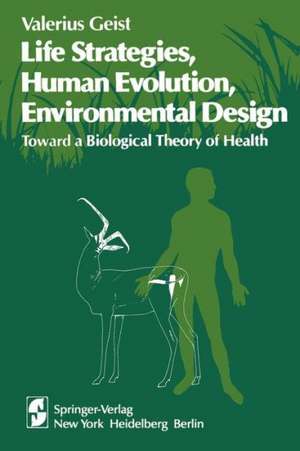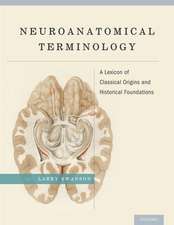Life Strategies, Human Evolution, Environmental Design: Toward a Biological Theory of Health
Autor V. Geisten Limba Engleză Paperback – 9 oct 2011
Preț: 651.51 lei
Preț vechi: 766.49 lei
-15% Nou
Puncte Express: 977
Preț estimativ în valută:
124.66€ • 130.51$ • 103.15£
124.66€ • 130.51$ • 103.15£
Carte tipărită la comandă
Livrare economică 08-22 aprilie
Preluare comenzi: 021 569.72.76
Specificații
ISBN-13: 9781461263272
ISBN-10: 1461263271
Pagini: 495
Ilustrații: XXII, 495 p. 9 illus.
Dimensiuni: 155 x 235 x 30 mm
Greutate: 0.73 kg
Ediția:1978
Editura: Springer
Colecția Springer
Locul publicării:New York, NY, United States
ISBN-10: 1461263271
Pagini: 495
Ilustrații: XXII, 495 p. 9 illus.
Dimensiuni: 155 x 235 x 30 mm
Greutate: 0.73 kg
Ediția:1978
Editura: Springer
Colecția Springer
Locul publicării:New York, NY, United States
Public țintă
ResearchCuprins
1 / Organism Theory: The Dictates of Genes, the Meanings of Environment.- Primary Rules of Reproductive Fitness.- Grand Strategies of Maintenance and Spread.- Rules of Conduct Dictated by the Mechanisms of Gene Transmission and Expression.- The Environment.- 2 / Cognition—Predictability.- A Predictable Environment.- Relation Between Pattern Matching and the Reafference Principle.- Pattern Matching.- Theory of Emotionality.- Intelligence, Creativity, Memory.- Structuring and Ontogeny of Cognitive Patterns.- Prediction With the Theory of Emotionality and Pattern Matching: From Sheep in Pastures to Conventional Wisdom.- 3 / Communication.- Origin, Components, and Definitions.- Some Principles of Communication: The Law of Least Effort.- Some Rules Governing Semantic and Pragmatic Structure of Signals: Novelty.- Antithesis or the Law of the Opposite.- Stimulus Contrast.- Redundancy.- Intention Movements—Iconic Signals.- Levels of Communication.- 4 / Aggression.- Competition.- Agonistic Adaptations.- Definition of Aggression.- The Phylogeny Fallacy.- Misadventures in Aggression.- Weapons and Defenses.- Retaliation as a Control on the Evolution of Aggression.- Armament and Ecological Strategy.- Circumstances and Aggression: Some Rules.- 5 / Dominance Displays: The Biology of Art, Pride—and Materialism.- Dominance Displays: Their Raison d’ Etre.- Characteristics of Dominance Displays.- Attention-Guiding Organs: The Biology of Art.- Quantitative Rules in Dominance Displays.- Ontogeny of Dominance Displays.- Evolutionary Directions in Dominance Displays.- Human Dominance Displays: Biological Basis of Displays and Their Cultural Enhancement.- Humor, Laughter, Courtesy.- Cultural Dominance Displays and Their Rules.- 6 / How Genes Communicate With the Environment—TheBiology of Inequality.- Phenotype Syndromes in Vertebrates.- Social and Psychological Factors Affecting Population Quality.- Two Explanatory Hypotheses Based on Cortical Dominance, Growth Priority, and Blood Flow.- Evolution and Adaptive Significance of Growth Priorities in Tissues: The Dispersal and Maintenance Phenotypes.- Phenotype Plasticity and Man.- 7 / Mammalian Systems.- Prelude to Mammalhood.- A New Ecological Profession or Ecological Niche.- From Reptile to Mammal: Locomotion, Tonus, Heat Production and Control.- From Bolting to Chewing.- Alterations of Digestive Glands and Ureotelism.- Bigger Kidney and Control Glands.- Larger Lungs, Bigger Heart, Simpler Circulation.- Adjusting Surface-to-Mass Ratio.- A Consequence of Tail Reduction: New Weapons and Defenses.- Toward Homeothermy.- Evolution of Hair.- A New Breathing System.- More Erythrocytes.- Olfaction, Scent Glands, Touch, and Hearing.- “Mnemotaxis”.- The Nest for the Young and for Digestion, Energy Stores, and Digging Paws.- Evolution of Parental Care and Lactation.- Diphyodonty.- New Bone Microstructure.- Sleep and Its Early Evolution.- Mammalian Liabilities: High-Cost, Short Life, High Aggression, Poor Performance in Heat and Desert.- 8 / Life Forms and Extinction.- Dynasties of the Past.- Extinction.- Life Forms.- 9 / The Ice Ages.- Tertiary and Pleistocene Giants and the Dispersal Theory.- The Tundra Ecosystem.- The Periglacial Ecosystem: The St. Elias Range.- The Elements of the Periglacial Ecosystem.- Habitat Mosaics as a Function of Periglacial Climatic and Edaphic Factors.- Biomass of Large Mammals.- Large Mammal Habitats in the Periglacial Zone.- Climatic Factors and Megafaunal Extinctions.- 10 / Prehumans.- The Early Hominids.- Adaptations to the Wet Savannah.- Adaptive Syndrome of theGracile Hominids.- Meat Diet: For and Against.- Social System.- Territoriality.- Significance of Tools.- Evolution of Conscience, Imitation and Faith.- 11 / The Homo erectus Stage.- Adaptive Successions: From Savannah to Steppe.- Australopithecine versus early Homo Characteristics.- Characteristics of the Steppe.- From Opportunistic to Systematic Hunting.- Roots of Language.- Geographic Dispersal and the Evolution of Homo erectus: Applying the Dispersal Theory.- An Overview of Homo erectus.- 12 / The First Advance to the Glaciers.- Late Acheulean Man and Temperate Climates.- Cooperative Hunting.- Evolution of Hairlessness.- Dictates of Cold Environments.- Neanderthal Man’s Characteristics.- On the Adaptive Syndrome of Neanderthal Man.- The Extinction of Neanderthal Man.- 13 / On the Evolution of Modern Man.- Early Environmental Settings.- Meat Conservation and its Consequences.- Chronologie Time and Big-Game Migrations.- Distance Confrontation Hunting and Complex Cooperative Hunting.- Before Cro-Magnon.- Some Attributes of Cro-Magnon.- The Early Anxieties.- Megafauna and Late Paleolithic Hunters.- On the Ecology of Bonding Male and Female.- Effects of Monogamy on the Dominance Displays and Courtship of Homo.- The Social Feedback System.- Prerequisites of Cooperation: Music, Dancing, Laughter, Language, Games.- Music: Its Functions and Possible Origins.- Extended Family.- Relict Behaviors.- Sexual Displays.- Neoteny.- 14 / From Periglacial to Artificial Environments.- Hunting Economics.- The Vitamin C Problem.- The Vitamin D Problem.- Parasites, Diseases, and Periglacial Hygiene.- How to Maximize Intellectual Development, Speed of Pattern Matching, and Creativity.- Magic Numbers.- The Social Environment.- The Mesolithic.- Geographic Dispersal of Modern Man..- On theOrigin of Medical and Pharmaceutical Knowledge.- The Beginning of Artificial Environments and Some of Their Biological Effects.- 15 / Health, Professionals, and Creature Comforts.- Professionals and Intervention.- On Health and a Healthful Environment.- Evolutionary Model of a Healthful Environment: Its Rationale.- Normative Environmental Criteria.- Quality of Life.- Creature Comforts.- Testing the Evolutionary Model.- The Evolutionary Model in Decision Making: Examples.- What are the Costs of Maximizing Individual Development?.- References.















